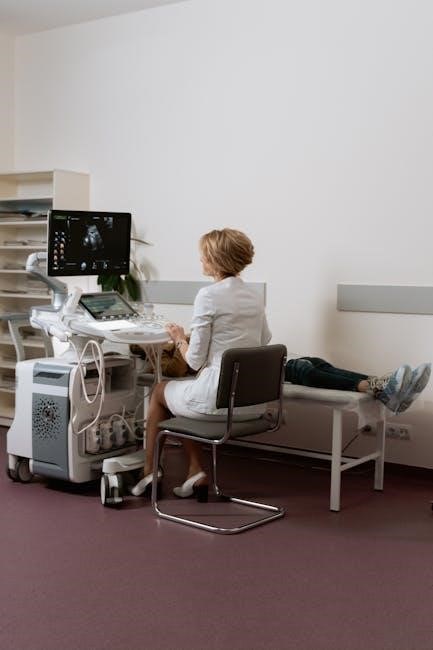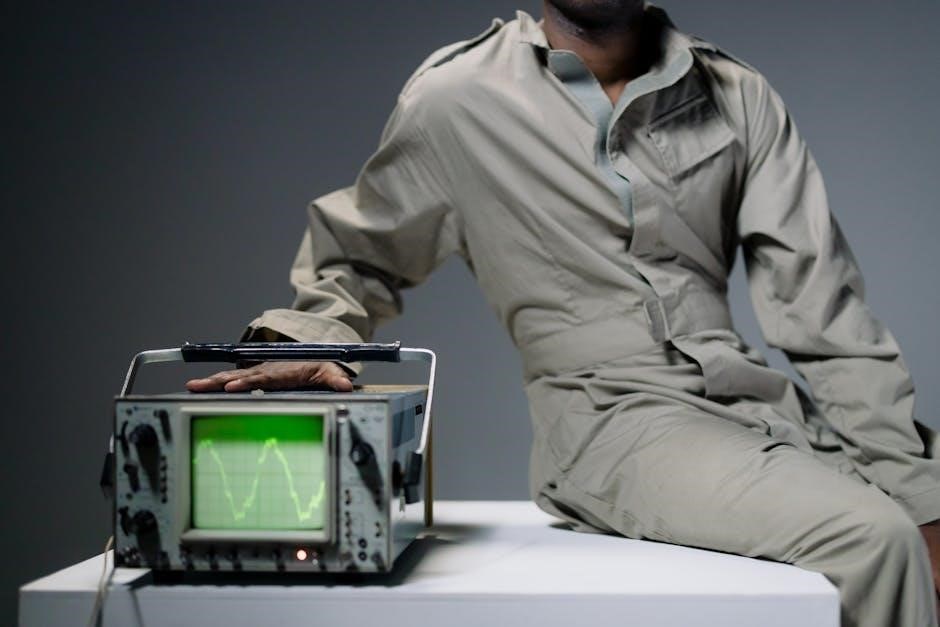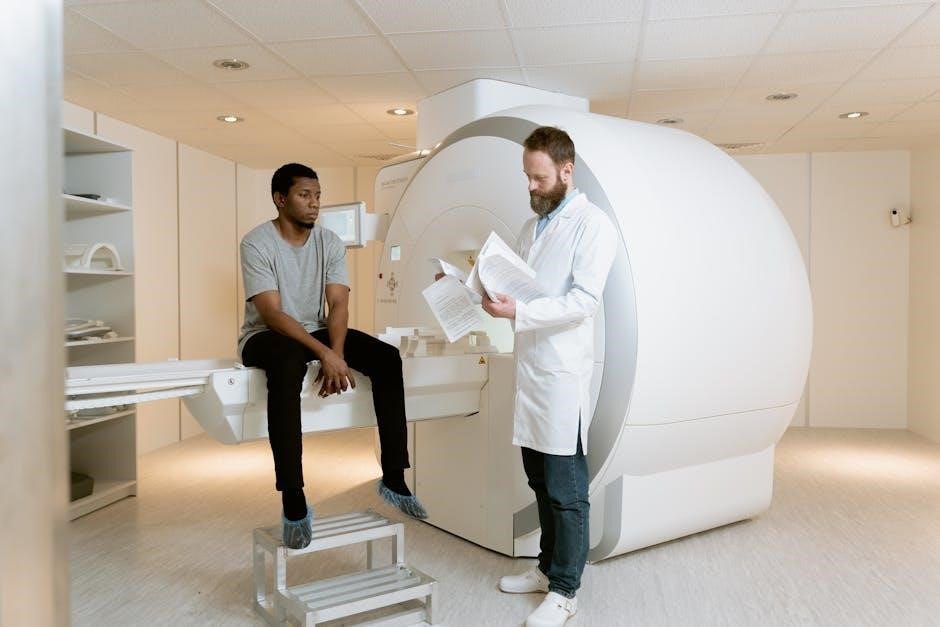
The Function in Sitting Test (FIST) is a performance-based assessment evaluating sitting balance and functional abilities in clinical settings, designed for patients with impaired postural control.
1.1 Purpose of the FIST
The primary purpose of the FIST is to assess a patient’s ability to maintain sitting balance and perform functional tasks while seated. It evaluates both static and dynamic balance, providing insights into postural control and movement patterns. The test is designed for individuals with impaired postural control, helping clinicians identify deficits and guide targeted interventions to improve sitting function and overall rehabilitation outcomes.
1.2 Key Features of the FIST
The FIST is a performance-based test consisting of 14 items assessing sitting balance and functional abilities. It evaluates static and dynamic balance, sensory, motor, proactive, reactive, and steady-state skills. The test is administered bedside, requiring minimal equipment. It takes 5-10 minutes, with tasks ordered by difficulty. Scoring is objective, providing clear insights into postural control deficits, making it a reliable tool for rehabilitation assessments.

Components of the FIST
The FIST includes 14 test items assessing sitting balance and functional tasks, such as static sitting, head movements, lifting legs, and reaching for objects, evaluating postural control.
2.1 Test Items and Tasks
The FIST comprises 14 distinct tasks designed to evaluate various aspects of sitting balance and functional ability. These tasks range from static sitting positions to dynamic movements, such as lifting a foot, reaching for objects, and rotating the trunk. Each item is structured to assess the patient’s ability to maintain posture and perform specific actions without losing balance, ensuring a comprehensive evaluation of seated postural control.
2.2 Types of Balance Assessed
The FIST evaluates various balance types, including sensory, motor, proactive, reactive, and steady-state balance. Sensory balance assesses how patients use visual, tactile, and vestibular inputs to maintain posture. Motor balance evaluates strength and coordination. Proactive balance involves anticipatory strategies, while reactive balance tests responses to external disturbances. Steady-state balance measures stability during voluntary movements, ensuring a comprehensive assessment of seated postural control abilities.

Administration of the FIST
The FIST is a bedside clinical measure, typically administered by healthcare providers like physical therapists, designed to evaluate sitting balance in 5-10 minutes.
3.1 Equipment and Setup Requirements
The FIST requires minimal equipment, including a firm chair with back support, armrests, and a footrest or stool for proper positioning. Patients should sit with hips and knees flexed at 90 degrees, feet flat on the floor or stool, and hands in their lap. The test is designed for bedside administration, ensuring accessibility in clinical settings with readily available materials.
3.2 Step-by-Step Administration Process
The FIST is administered in a clinical or bedside setting, beginning with static sitting for 30 seconds. Patients then perform tasks like head movements, lifting feet, and reaching for objects. Each of the 14 items is completed in order of increasing difficulty, ensuring a thorough assessment of sitting balance and functional abilities. The test typically takes 5-10 minutes to administer.

Scoring and Interpretation of FIST Results
The FIST uses a scoring system to evaluate performance across 14 tasks, assessing sitting balance and functional abilities. Scores are interpreted to determine baseline function, track progress, and guide clinical decision-making.
4.1 Scoring Criteria and Scale
The FIST uses a 4-point ordinal scale, ranging from 0 (unable to perform) to 4 (optimal performance). Each of the 14 items evaluates specific sitting balance tasks, such as maintaining posture, trunk rotation, and limb movements. Scores are summed to provide a total range of 0 to 56, with higher values indicating better functional sitting ability and balance control.
Interpretive guidelines categorize scores into functional levels, helping clinicians set rehabilitation goals and monitor progress over time. This standardized scoring system ensures consistency and reliability in assessing patient performance across clinical settings.
4.2 Interpreting Patient Performance
The FIST scores help clinicians identify balance deficits and functional sitting abilities. Higher scores indicate better performance, guiding rehabilitation goals. The test assesses sensory, motor, and reactive skills, enabling targeted interventions; Clinicians use the results to monitor progress and adjust treatment plans, ensuring personalized care for improved patient outcomes in sitting balance and functional tasks.

Clinical Applications of the FIST
The FIST is widely used in clinical settings to assess sitting balance and functional abilities, aiding in rehabilitation planning for patients with postural control deficits and impairments.
5.1 Use in Rehabilitation Settings
The FIST is a valuable tool in rehabilitation settings, helping therapists assess sitting balance and guide targeted interventions. It evaluates a patient’s ability to perform functional tasks while seated, providing insights into postural control, sensory integration, and motor strategies. Clinicians use FIST results to design personalized treatment plans and track progress in patients recovering from stroke, spinal cord injuries, or other conditions affecting balance and mobility. This tool enhances patient engagement and ensures effective rehabilitation outcomes by focusing on practical, everyday functions.
5.2 Application in Patient Populations
The FIST is widely applied in various patient populations, including those with stroke, spinal cord injuries, traumatic brain injuries, and orthopedic conditions. It effectively assesses sitting balance in individuals with impaired postural control, aiding in post-stroke recovery and rehabilitation. The test is particularly useful for patients transitioning from bed to chair, ensuring safe and functional progress in early rehabilitation stages.

Validity and Reliability of the FIST
The FIST has demonstrated strong validity and reliability in assessing sitting balance across various patient populations, supported by clinical research and studies on its effectiveness.
6.1 Research on Test Validity
Research confirms the FIST’s validity as a reliable measure of sitting balance and functional performance. Studies demonstrate its effectiveness in assessing postural control across diverse patient populations, including those in rehabilitation settings. The test’s ability to evaluate sensory, motor, and proactive balance skills has been validated, making it a trusted tool for clinicians. Its responsiveness to functional changes further supports its clinical utility.
6.2 Studies on Test Reliability
Studies have consistently demonstrated the FIST’s high reliability as a clinical assessment tool. The test exhibits strong internal consistency and excellent inter-rater reliability, ensuring accurate and reproducible results. Examiner consistency is maintained through standardized administration, and test-retest reliability is robust. These findings underscore the FIST’s dependability in evaluating sitting balance and functional performance across diverse patient populations and clinical settings, making it a valuable tool for tracking patient progress over time.

The Role of the FIST in Patient Care
The FIST enhances patient care by providing targeted interventions, tracking progress, and engaging patients in their recovery journey through its structured assessment of sitting balance and functional abilities.
7.1 Informing Treatment Interventions
The FIST provides valuable insights into a patient’s sitting balance and functional abilities, enabling clinicians to design targeted interventions. By identifying specific deficits, the test informs the prescription of exercises, adaptive equipment, and strategies to enhance postural control and mobility. This data-driven approach ensures personalized care, addressing the unique needs of each patient and promoting effective rehabilitation outcomes in clinical settings.
7.2 Monitoring Progress and Outcomes
The FIST serves as a reliable tool for tracking patient progress over time. Regular administration allows clinicians to measure improvements in sitting balance and functional performance, providing objective data to adjust treatment plans. This longitudinal assessment helps identify plateaus or advancements, ensuring interventions remain effective and patient outcomes are consistently moving toward recovery and functional independence.

The FIST in PDF Format
The FIST PDF provides a structured format for assessing sitting balance, offering a convenient and standardized tool for clinicians to evaluate and document patient progress effectively.
8.1 Benefits of the PDF Version
The FIST in PDF format offers portability, easy access, and standardized administration. It simplifies documentation, reduces storage needs, and enables quick sharing among healthcare providers. The PDF version ensures consistency in assessment procedures, enhancing reliability and efficiency in clinical settings. Its professional layout and organization make it user-friendly, facilitating accurate scoring and interpretation of patient performance. This format is ideal for integrating into electronic health records, streamlining patient care workflows and improving communication across multidisciplinary teams. Clinicians can easily print or digitally distribute the FIST PDF, making it a practical tool for both inpatient and outpatient rehabilitation environments. Additionally, the PDF version allows for easy updates, ensuring clinicians always have the most current assessment tools at their disposal, which is critical for maintaining best practices in patient care and rehabilitation outcomes. The convenience and accessibility of the FIST PDF make it an indispensable resource for physical therapists and other healthcare professionals focused on improving sitting balance and functional abilities in their patients.
8.2 How to Use the FIST PDF in Practice
Download and print the FIST PDF or access it digitally for bedside administration. Ensure the patient is seated with proper posture and necessary support. Follow the test items in order, using the provided scoring criteria to evaluate performance. Document results accurately for progress tracking and treatment planning. Store completed assessments in patient records for future reference and multidisciplinary communication. The PDF format allows for easy integration into electronic health records, streamlining clinical workflows and ensuring consistent documentation. Clinicians can also use the PDF to educate patients and caregivers about sitting balance exercises and progress. Regular use of the FIST PDF promotes standardized assessment and targeted interventions, enhancing patient outcomes in rehabilitation settings.

Case Studies and Practical Examples
A patient with impaired sitting balance post-stroke demonstrated improved FIST scores from 6/14 to 10/14 after targeted interventions, highlighting the test’s practical application in rehabilitation progress tracking.
9.1 Example of FIST Administration
The FIST involves 14 tasks, such as maintaining static sitting, moving the head side-to-side, lifting a foot, and picking up an object. Patients perform tasks sequentially, with scores based on balance and execution. For example, a patient post-stroke may struggle with lifting their foot but succeed after practice, demonstrating progress in functional sitting abilities and rehabilitation outcomes. This practical assessment guides targeted interventions.
9.2 Impact on Patient Outcomes
The FIST significantly improves patient outcomes by enhancing functional sitting balance and mobility. Patients post-stroke or with impaired postural control show improved stability and reduced fall risks. Clinicians use FIST scores to tailor interventions, accelerating recovery and independence. Regular assessments track progress, ensuring targeted adjustments to treatment plans, ultimately leading to better long-term functional abilities and quality of life for patients in rehabilitation settings.

Comparing the FIST to Other Functional Tests
The FIST is often compared to the Sit-to-Stand Test (STS) for assessing functional mobility. While STS measures standing transitions, FIST focuses on seated balance and postural control, offering unique insights into sitting function. Unlike the Incremental Shuttle Walk Test (ISWT), which evaluates cardiovascular capacity, FIST specifically targets balance and stability in sitting positions, making it a valuable complementary tool in rehabilitation assessments.
10.1 Similarities with the Sit-to-Stand Test
The FIST and Sit-to-Stand Test (STS) share the goal of assessing functional mobility and lower limb strength. Both tests are performance-based, easy to administer, and require minimal equipment, making them practical for clinical settings. They also provide objective measures of physical function, aiding in tracking patient progress over time. However, while STS focuses on transitions from sitting to standing, FIST emphasizes seated balance and stability, addressing different aspects of functional ability. These similarities highlight their complementary roles in comprehensive rehabilitation assessments.
10.2 Unique Aspects of the FIST
The FIST uniquely focuses on seated postural control and functional tasks, offering a detailed assessment of static and dynamic sitting balance. It evaluates sensory, motor, and reactive balance abilities, distinguishing it from other tests. The FIST’s 14-item structure provides a comprehensive evaluation of seated functional abilities, addressing both stability and movement, making it a valuable tool for targeted rehabilitation interventions and progress monitoring in clinical settings.
The FIST provides valuable clinical insights into sitting balance and function, aiding rehabilitation. Future directions may include expanding its scope and integrating technology for enhanced assessment capabilities.
11.1 Summary of the FIST’s Importance
The Function in Sitting Test (FIST) is a vital clinical tool for assessing sitting balance and functional abilities, particularly in rehabilitation settings. Its reliability and validity make it a trusted measure for healthcare providers to evaluate postural control and guide targeted interventions. By streamlining balance assessments, the FIST enhances patient care, aiding in the development of effective treatment plans and monitoring progress over time.
11.2 Potential for Future Development
The FIST holds promise for future enhancements, such as integrating technology for remote assessments and expanding its application to diverse patient populations. Future research could explore its use in telehealth settings, allowing clinicians to assess sitting balance remotely. Additionally, developing culturally adapted versions and refining scoring systems could further enhance its utility and accessibility for global clinical practice.